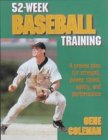At least once a week I get an e-mail from a parent wanting to know
if his/her son should do bench presses. The athlete in question is
usually a pitcher and/or quarterback and the parent wants to make
sure that he doesn't get so tight that he can't throw.
Well, the answer, more often than not, is yes. Barring a significant
orthopedic problem, I recommend that most developing athletes do
some form of upper body chest exercise. The secret to successful,
injury-free performance is muscle balance, and you can't have
balance if you neglect your chest. You don't have to lift a lot
of weight, but you do have to lift enough to strengthen the muscles,
tendons and ligaments that protect the joint.
What about getting too tight? Getting too tight is usually the
result of improper training. If you train your chest without
giving equal time to your back, you can become front side dominant,
which could limit range of motion in the shoulder.
Another potential problem when doing bench presses is letting
the elbows drop too low. Most lifters mistakenly believe that you have to let the bar touch your chest on each rep. If you have a thick chest and short arms, this might be okay. If, however, you have a thin chest and long arms, letting the bar touch the chest can be dangerous.
The key to a safe bench is to keep the elbows from going too low.
Lower them until your upper arms form a right angle with your
forearms at the elbow joint. If you let them go too low, you risk
stretching the anterior capsule and compressing the posterior
capsule of the shoulder.
To get the right technique, try this. Lie on the floor with your
arms extended straight up without any weight in your hands. This
is the proper starting or "up" position. Now, let your elbows come
down and away from your sides until they touch the floor. This is
the proper ending or "down" position. Remember it and use it when
you get on a bench.
A good alternative to the bench is the dumbbell bench press. You
can do it from a flat bench or from the floor. Again, the key is to
keep the elbows from going too low. The DB bench offers a few
advantages to the throwing athlete that you can't get from the
standard bench.
First, it develops better balance and coordination of movement
because the arms are working independently of each other. Second,
because it requires more balance, there is less chance of lifting
too much weight. Third, and most importantly, the plane of movement
is consistent with the way the shoulder joint functions.
Doing a proper DB bench press requires three steps: (1) Start in
the up position with your palms facing forward and the DBs touching
each other over your chest. (2) Lower the DBs until your elbows form
a right angle. (3) Press up and in until the DBs come together over
your chest. You want to form a pyramid with your hands. The base is
at the bottom and the peak is at the top of the lift. This is the
"natural" way that your shoulders move - "from out to in". Doing a
bench press with a bar is not as natural. Because of hand placement,
the movement is up and out.
If you're a throwing athlete, and you use proper lifting technique,
the bench and/or DB bench can be safe, effective exercises to
improve performance and minimize the risk of injury.
To get more information about Dr. Coleman's technique's
Follow these links
Dr. Coleman's Book

Astros Fitness Online
All Pro Training
